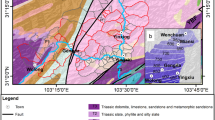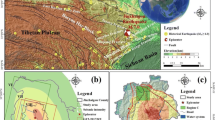Abstract
The Wenchuan earthquake that occurred on 12 May 2008 induced numerous landslides. Loose landslide materials were deposited on hillslopes, and deep channels were easily remobilized and transformed into debris flows by extreme rainstorms. Twelve years after the Wenchuan earthquake, debris flows were still active in the Qipangou Ravine in the quake-hit area. In this paper, we continuously tracked the spatiotemporal evolution of the landslides and vegetation restoration and evaluated the evolution of debris flow activity in the Qipan catchment with the aid of a GIS platform and field investigations from 2008 to 2019. We observed that the area with active landslides increased sharply immediately following the earthquake, and then decreased with time; however, the total area of landslides continued to increase from 6.93 km2 in 2008 to 10.55 km2 in 2019. The active landslides shifted towards lower angles and higher elevations after 2013. Since 2009, the vegetation coverage has been gradually increasing and approaching the coverage present before the earthquake as of 2019. The landslide activity was high and the vegetation recovery rates were rapidly rising during the first five years after the earthquake; the recovery rates then slowed over time. Therefore, we divided the evolution that occurred during the post landslide period into an active period (2008–2013), a self-adjustment period (2013–2026) and a stable period (after 2026). We then proposed a quantitative model to determine the trends of landslide activity rates and NDVI values in the catchment, which indicated that the landslide activities and postseismic vegetation restoration rates in this catchment will return to preseismic levels within approximately two decades. We also analysed the runout volumes of the debris flows after the earthquakes (Diexi and Wenchuan) and the standard deviation of the vegetation coverage and predicted that the debris flow activities will last for an additional 50 years or more.
Similar content being viewed by others
References
Chen M, Tang C, Xiong J, et al. (2020) The long-term evolution of landslide activity near the epicentral area of the 2008 Wenchuan earthquake in China. Geomorphology 367: 107317. https://doi.org/10.1016/j.geomorph.2020.107317
Cui P, Lin YM, Chen C (2012) Destruction of vegetation due to geo-hazards and its environmental impacts in the Wenchuan earthquake areas. Eng Geol 44: 61–69. https://doi.org/10.1016/j.ecoleng.2012.03.012
Domènech G, Fan XM, Scaringi G, et al. (2019) Modelling the role of material depletion, grain coarsening and revegetation in debris flow occurrences after the 2008 Wenchuan earthquake. Eng Geol 250: 34–44. https://doi.org/10.1016/j.enggeo.2019.01.010
Dou J, Yunus AP, Merghadi A, et al. (2020) Different sampling strategies for predicting landslide susceptibilities are deemed less consequential with deep learning. Sci Total Environ 720: 137320. https://doi.org/10.1016/j.scitotenv.2020.137320
Dou J, Yunus AP, Tien Bui D, et al. (2019) Evaluating GIS-based multiple statistical models and data mining for earthquake and rainfall-induced landslide susceptibility using the LiDAR DEM. Remote Sens 11(6): 638. https://doi.org/10.3390/rs11060638
Fan XM, Scaringi G, Domènech G, et al. (2019) Two multi-temporal datasets that track the enhanced landsliding after the 2008 Wenchuan earthquake. Earth Syst Sci Data 11(1): 35–55. https://doi.org/10.5194/essd-11-35-2019
Hu T, Huang RQ (2017) A catastrophic debris flow in the Wenchuan Earthquake area, July 2013: characteristics, formation, and risk reduction. J Mt Sci 14(1): 15–30. https://doi.org/10.1007/s11629-016-3965-8
Hu W, Dong XJ, Xu Q, et al. (2016) Initiation processes for runoff generated debris flows in the Wenchuan earthquake area of China. Geomorphology 253: 468–477. https://doi.org/10.1016/j.geomorph.2015.10.024
Huang RQ, Li WL (2014) Post-earthquake landsliding and long-term impacts in the Wenchuan earthquake area, China. Eng Geol 182: 111–120. https://doi.org/10.1016/j.enggeo.2014.07.008
Huang RQ, Yu B, Hu W, et al. (2016) The long-term geologic hazards and consequent risk after the Wenchuan earthquake. Landslides and Engineered Slopes. Experience, Theory and Practice. Florida: CRC Press. pp 233–258. https://doi.org/10.1201/b21520-21
Jiang WG, Jia K, Wu JJ, et al. (2015) Evaluating the vegetation recovery in the damage area of Wenchuan earthquake using MODIS data. Remote Sens 7(7): 8757–8778. https://doi.org/10.3390/rs70708757
Jiao QJ, Zhang B, Liu LY, et al. (2014) Assessment of spatio-temporal variations in vegetation recovery after the Wenchuan earthquake using Landsat data. Nat Hazards 70(2): 1309–1326. https://doi.org/10.1007/s11069-013-0875-8
Jin W, Zhang G, Zou Q, et al. (2019) A new understand of the activity behavior of post-erathquake debris flow—Taking the “8.20”event in Wenchuan, Sichuan, China as an example. Mt Res 37(5): 787–796. (In Chinese) https://doi.org/10.16089/j.cnki.1008-2786.000469
Justice CO, Townshend JRG, Holben BN, et al. (2007) Analysis of the phenology of global vegetation using meteorological satellite data. Int J Remote Sens 6(8): 1271–1318. https://doi.org/10.1080/01431168508948281
Khan SF, Kamp U, Owen LA (2013) Documenting five years of landsliding after the 2005 Kashmir earthquake, using repeat photography. Geomorphology 197: 45–55. https://doi.org/10.1016/j.geomorph.2013.04.033
Li CR, Wang M, Liu K (2018) A decadal evolution of landslides and debris flows after the Wenchuan earthquake. Geomorphology 323: 1–12. https://doi.org/10.1016/j.geomorph.2018.09.010
Li JZ, Cao M, Qiu HJ, et al. (2016) Spatial-temporal process and characteristics of vegetation recovery after Wenchuan earthquake: A case study in Longxi River basin of Dujiangyan. China Chinese Journal of Applied Ecology 27(11): 3473–3486. (In Chinese) https://doi.org/10.1007/s10346-018-1054-5
Lin CY, Lo HM, Chou WC, et al. (2004) Vegetation recovery assessment at the Jou-Jou Mountain landslide area caused by the 921 Earthquake in Central Taiwan. Ecol Model 176(1–2): 75–81. https://doi.org/10.1016/j.ecolmodel.2003.12.037
Lin WT, Chou WC, Lin CY, et al. (2005) Vegetation recovery monitoring and assessment at landslides caused by earthquake in Central Taiwan. For Ecol Manage 210(1–3): 55–66. https://doi.org/10.1016/j.foreco.2005.02.026
Lin WT, Lin CY, Chou WC (2006) Assessment of vegetation recovery and soil erosion at landslides caused by a catastrophic earthquake: a case study in Central Taiwan. Ecol Eng 28(1): 79–89. https://doi.org/10.1016/j.ecoleng.2006.04.005
Liu SH, Lin C W, Tseng CM (2013) A statistical model for the impact of the 1999 Chi-Chi earthquake on the subsequent rainfall-induced landslides. Eng Geol 156(11): 11–19. https://doi.org/10.1016/j.enggeo.2013.01.005
Lobet G, Couvreur V, Meunier F, et al. (2014) Plant water uptake in drying soils. Plant Physiol 164(4): 1619–1627. https://doi.org/10.1104/pp.113.233486
Mondini A C, Guzzetti F, Reichenbach P, et al. (2011) Semiautomatic recognition and mapping of rainfall induced shallow landslides using optical satellite images. Remote Sens Environ 115(7): 1743–1757. https://doi.org/10.1016/j.rse.2011.03.006
Nakamura H, Tsuchiya S, Inoue K, et al. (2000) Sabo Against Earthquakes. Kokon Shoin, Tokyo. pp 190–220 (In Japanese).
Reubens B, Poesen J, Danjon F, et al. (2007) The role of fine and coarse roots in shallow slope stability and soil erosion control with a focus on root system architecture: a review. Trees 21(4): 385–402. https://doi.org/10.1007/s00468-007-0132-4
Saba SB, van der Meijde M, van der Werff H (2010) Spatiotemporal landslide detection for the 2005 Kashmir earthquake region. Geomorphology 124(1–2): 17–25. https://doi.org/10.1016/j.geomorph.2010.07.026
Shen P, Zhang L, Chen H, et al. (2018) EDDA 2.0: integrated simulation of debris flow initiation and dynamics considering two initiation mechanisms. Geosci Model Dev 11(7): 2841–2856. https://doi.org/10.5194/gmd-11-2841-2018
Shen P, Zhang LM, Fan RL, et al. (2020) Declining geohazard activity with vegetation recovery during first ten years after the 2008 Wenchuan earthquake. Geomorphology 352: 106989. https://doi.org/10.1016/j.geomorph.2019.106989
Stokes A, Atger C, Bengough AG, et al. (2009) Desirable plant root traits for protecting natural and engineered slopes against landslides. Plant Soil 324(1–2): 1–30. https://doi.org/10.1007/s11104-009-0159-y
Tang C, Jiang ZL, Li WL (2015) Seismic Landslide Evolution and Debris Flow Development: A Case Study in the Hongchun Catchment, Wenchuan Area of China. In: Lollino G. et al. (eds. Engineering Geology for Society and Territory — Volume 2. Springer, Cham. pp 445–449. https://doi.org/10.1007/978-3-319-09057-3_72
Tang C, Westen CJV, Tanyas H, et al. (2016) Analysing post-earthquake landslide activity using multi-temporal landslide inventories near the epicentral area of the 2008 Wenchuan earthquake. Nat Hazards Earth Syst Sci 16(12): 1–26. https://doi.org/10.5194/nhess-16-2641-2016
Tang C, Zhu J, Qi X, et al. (2011) Landslides induced by the Wenchuan earthquake and the subsequent strong rainfall event: A case study in the Beichuan area of China. Eng Geol 122(1–2): 22–33. https://doi.org/10.1016/j.enggeo.2011.03.013
Wynn TM, Mostaghimi S (2006) Effects of riparian vegetation on stream bank subaerial processes in southwestern Virginia, USA. Earth Surf Process Landf 31(4): 399–413. https://doi.org/10.1002/esp.1252
Xu C, Xu X, Yao X, et al. (2014) Three (nearly) complete inventories of landslides triggered by the May 12, 2008 Wenchuan Mw 7.9 earthquake of China and their spatial distribution statistical analysis. Landslides 11(4): 441–461. https://doi.org/10.1007/s10346-013-0404-6
Yang WT, Qi WW, Zhou JX (2018a) Effects of precipitation and topography on vegetation recovery at landslide sites after the 2008 Wenchuan earthquake. Land Degrad Dev 29(10): 3355–3365. https://doi.org/10.1002/ldr.3098
Yang WT, Qi WW, Zhou JX (2018b) Decreased post-seismic landslides linked to vegetation recovery after the 2008 Wenchuan earthquake. Ecol Indic 89: 438–444. https://doi.org/10.1016/j.ecolind.2017.12.006
Yunus AP, Fan XM, Tang XL, et al. (2020) Decadal vegetation succession from MODIS reveals the spatio-temporal evolution of post-seismic landsliding after the 2008 Wenchuan earthquake. Remote Sens Environ 236: 111476. https://doi.org/10.1016/j.rse.2019.111476.
Zhang H, Chi T, Fan J, et al. (2015) Spatial analysis of Wenchuan earthquake-damaged vegetation in the mountainous basins and its applications. Remote Sens 7(5): 5785–5804. https://doi.org/10.3390/rs70505785
Zhang S, Zhang LM (2017) Impact of the 2008 Wenchuan earthquake in China on subsequent long-term debris flow activities in the epicentral area. Geomorphology 276: 86–103. https://doi.org/10.1016/j.geomorph.2016.10.009
Zhu H, Zhang LM (2015) Field investigation of erosion resistance of common grass species for soil bioengineering in Hong Kong. Acta Geotech 11(5): 1047–1059. https://doi.org/10.1007/s11440-015-0408-6
Zhu H, Zhang LM, Garg A (2018) Investigating plant transpiration-induced soil suction affected by root morphology and root depth. Comput. Geotech 103: 26–31. https://doi.org/10.1016/j.compgeo.2018.06.019
Acknowledgements
This work was supported by the National Key Research and Development Program of China (No. 2017YFC1501004) and the National Natural Science Foundation of China (No. 41672299). The authors thank the anonymous reviewers for their helpful suggestions to improve the paper.
Author information
Authors and Affiliations
Corresponding author
Rights and permissions
About this article
Cite this article
Shi, Qy., Tang, C., Gong, Lf. et al. Activity evolution of landslides and debris flows after the Wenchuan earthquake in the Qipan catchment, Southwest China. J. Mt. Sci. 18, 932–951 (2021). https://doi.org/10.1007/s11629-020-6494-4
Received:
Revised:
Accepted:
Published:
Issue Date:
DOI: https://doi.org/10.1007/s11629-020-6494-4




